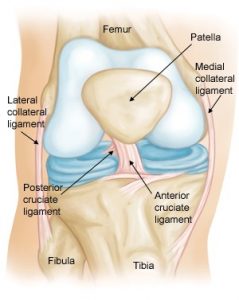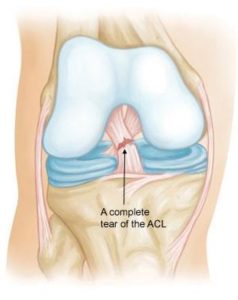The ACL (Anterior Crucial Ligament)
What is the ACL and why is it important?
- The Anterior Crucial Ligament, (ACL) is in the front of the knee. It is considered a key knee stabilizer muscle in the anterior knee, it connects your thigh bone to your shinbone, (the femur bone to the tibia bone). The ACL is one of 4 ligaments that help stabilize the knee. The anterior cruciate ligament prevents the femur from sliding backward on the tibia, or the tibia sliding forward on the femur. Cruciate is a Latin word for cross-shaped, the reason being that the Anterior and Posterior CRUCIATE Ligament cross each other making the appearance of a cross shape. The knee is considered a synovial hinge joint. The knee flexes and extends the knee, with range of motion usually ranging around 120 degrees of flexion. The knee is one of the largest and complex joints in the body. The femur connects through the 4 ligaments and other tissue like muscles and fascia, to the tibia, and the fibula that runs along the tibia. The Patella sits in front of the Femur and is connected to the thigh via the Quadriceps tendon, and the Tibia via the Patellar tendon ligament.
WHAT ARE THESE ISSUES IN THESE TISSUES!
Focusing on ACL Sprains and Tears:
ACL injury can be a tear or sprain of the ACL itself. One of the more common knee injuries, the ACL is typically injured during sports activities. It’s found commonly with sports that involve sudden stops or changes in direction, jumping and landing. Some of these sports include; soccer, basketball, football, and skiing. I have often thought about Barry Sanders and how he could juke like he did, and not tear his ACL!
SYMPTOMS:
Often times people will; hear a pop and even feel a popping sensation, have severe pain when walking, going downstairs, or even laying on the affected side, rapid swelling, loss in range of motion, and a feeling of instability, or a feeling of the, “knee going out”.
FACTORS:
Some factors may include; females are more likely to have this issue, some sports as listed above, bad conditioning, wearing the wrong shoes, or wearing them improperly. People who have ACL injuries have been known to have a higher risk of osteoarthritis.
PREVENTION
“AN OUNCE OF PREVENTION IS WORTH A POUND OF CURE” – Benjamin Franklin
ONE WAY TO PREVENT ACL RELATED INJURIES:
“You can prevent most ACL knee injuries by just knowing what to do and when to do it” – Chad Clark, MSPT, CSCS
Physical Therapy can help prevent ACL injuries by helping strengthen and improve balance to the knee. Some PT’s like Chad Clark, MSPT, CSCS specialize in Knee Pain and ACL prevention programs. With degrees in both physical therapy and certified strength and conditioning specialist, Chad, and PT’s like him have an interest in helping those with weak knees become more pain free, healthy, and active. This is what he has to say about how he helps his patients with knee pain and ACL prevention treatments, “Not all traditional Knee pain and ACL Prevention treatments lead to a better posture (not by any means). And believe it or not, some may actually make your knee strength and balance worse! Not all practitioners treat knee pain and ACL tears the same. And not all treatments target these 3 planes of motion.
My method is highly unique. I focus on balancing the 3 important planes of motion (and the entire body) to get quick maximum results.
My years of experience and research has led to the discovery of this revolutionary new way to stop knee pain and PREVENT ACL TEARS in nearly almost anyone of any age, body type, or condition.”-Chad Clark MSPT, CSCS
MASSAGE THERAPY AND ACL
Massage Therapy has been known to help increase blood flow, help aid in range of motion, and muscle flexibility, and generally just feels great! Massage may aid in injury prevention, by these benefits combined with either PT, exercise, or even as a post-surgical treatment, (with the surgeon’s permission or referral).
I have personally worked on dozens of clients that have had problems in the past, surgeries, or recent injuries. Though most times massage can’t be the only modality one picks when choosing therapy for injuries, it can help with prevention of injury to the body. Massage is a great adjunct to anything else one may do to prevent and or recover from an ACL or knee related injury. I have been able to help people stave off surgery and recover faster from post-surgical stiffness, by increasing range of motion, and decreasing pain and discomfort. One client had this to say, “After my bi-lateral knee replacement I wasn’t able to hardly move, and it took over two weeks to get into physical therapy. My Dr. was not pleased and thought I needed another surgery to get better. After my first session with Michael Coffee, I was able to sleep without pain, and the PT and Massage has helped my range, so the Dr. isn’t worried anymore” John.
Be sure to RSVP to Chad Clark’s ACL and knee injury prevention seminar on 6/18/2019 from 5-6 pm inside of the PT-Connections Clinic. Learn more here https://pt-connections.com/chads-acl-and-knee-injury-prevention-workshop/ or call 719-565-6678. We’ll see you soon!



